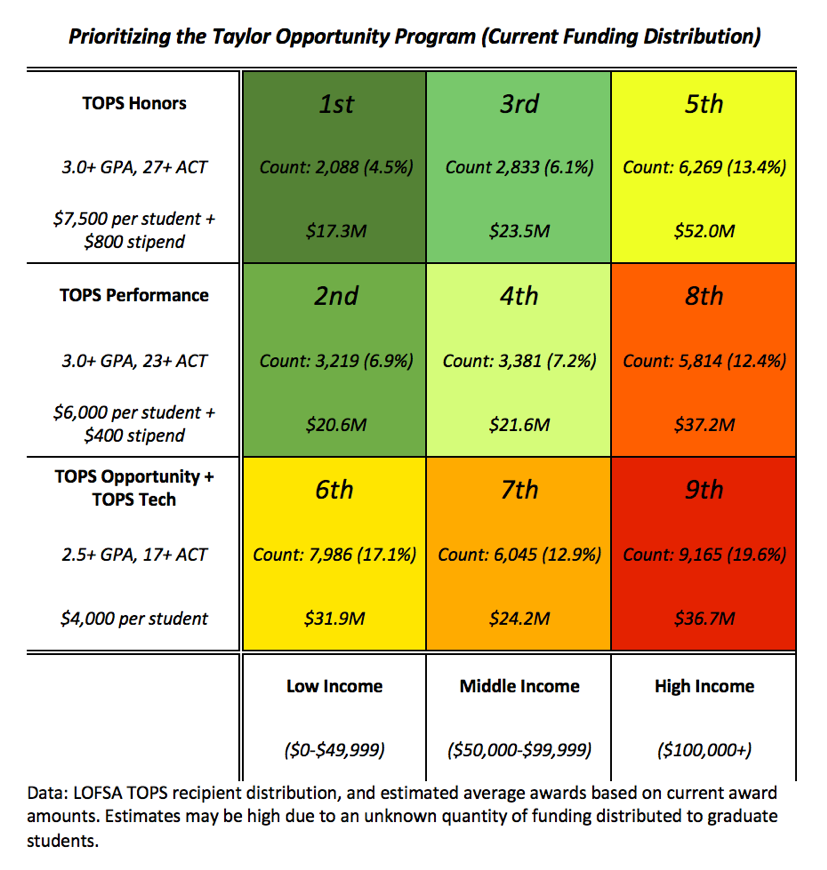“If you have to be cynical, if you can’t think about the kids, if you can’t acknowledge that our society owes them a chance, then fine. I’ll settle it for you: Educate them or support them. Can we build enough projects? Enough prisons? Can we hire enough policemen? Can we, in fact, support them?”
– Patrick F. Taylor (Namesake of the TOPS Program)
What is “merit”?
An individual who is meritorious is praiseworthy, admirable, worthy, and deserving. They have taken actions and achieved something that is above and beyond normal expectations. Typically, in higher education circles, so-called ‘merit’-based scholarships are those that go to students who have reached a high standard of academic achievement.
The State of Louisiana has the oldest, and the third largest, merit-based scholarship program in the country. The Taylor Opportunity Program for Students (TOPS) offers scholarships to over 16,000 TOPS students in the Louisiana State University system alone and nearly 50,000 statewide. The program consists of four levels of scholarship funding, guaranteeing significant resources (plus a stipend for the highest performers) to any Louisiana resident who meets academic standards and wishes to attend a Louisiana public college, university, or any institution affiliated with the Louisiana Association of Independent Colleges and Universities.
The program has not always been this large. The TOPS program was originally a program designed for high achieving students from low-income backgrounds only, but the state expanded access to students of all financial backgrounds in 1997. This had two effects: First, the program costs ballooned to over $290 million as tens of thousands of students gained access. Second, the scholarship shifted from a program aimed at helping low-income students to one where over half of recipients came from households earning $70,000 or more per year. In Louisiana, that’s an upper middle class income. Furthermore, while 44 percent of Louisiana’s primary and secondary school students are black, 70 percent of TOPS recipients in 2017 were white.
The rapidly rising cost of TOPS and a $1 billion budget shortfall brought the popular scholarship program into the spotlight. Louisiana’s Republican-controlled House narrowly passed a state operating budget that would cut TOPS funding by 20 percent ($58 million). Applied pro-rata, this cut would dramatically reduce the benefits of the program for all of its recipients but would especially impact the students from low-income and disadvantaged backgrounds who count on these resources in order to access higher education.
This brings us back to the question of what ‘merit’ is, especially in the context of higher education. It is no secret that low-income students, on average, face major educational hurdles relative to their wealthier peers. They exhibit less-developed math and reading skills entering school, and in the long run, and their parents have far less capacity to hire tutors and provide resources to close those gaps.
Put another way, relative to their wealthier peers, students from low-income backgrounds who exhibit high academic achievement have accomplished something especially meritorious and above normal expectations. They are the gold star students. Meanwhile, (not to detract from their achievements) high-income students who maintain high academic achievement are simply meeting expectations.
This means that a flat, pro-rated cut to the TOPS program does not effectively award hard-earned achievement. If funding must be cut, we at Education Reform Now (ERN) proposed that administrators should focus full scholarships to the students who have exhibited the most merit, first — and prioritize the remaining resources accordingly.
Consider the above chart, in which the current funding outlays are estimated across all TOPS performance levels and income brackets. Presently, over $110 million of the TOPS budget, nearly 40 percent of it, goes to students from households earning over $100,000 a year. If the cuts occur and TOPS is reduced, we propose guaranteeing the most meritorious students – low-income TOPS Honors and Performance recipients – full TOPS funding based on current levels. After those approximately $38 million are disbursed, there would still be plenty of money left over to distribute among the remaining high performing students who have far less need and could absorb funding cuts more easily.
Guaranteeing full scholarships to low-income high-performing students first is not just the right thing to do, but it is the most fiscally responsible choice for Louisiana. Low income children, especially low-income black children, are highly likely to remain low-income as adults. However, the impact of higher education on economic outcomes is greater now than it has ever been. Prioritizing TOPS is more likely to help move students from the lowest income quintile to the highest – the greatest return on investment. And, as Mr. Taylor noted at the founding of the program, economic mobility results in reduced need for other expensive government functions.
Unfortunately, despite numerous complaints about the cost of the program, legislators in Baton Rouge did not seem to want to take advantage of the opportunity for real reform. State Rep. Gary Carter (D–Orleans) introduced H.B. 399, which sought to prioritize full TOPS scholarships to the highest performing students as well as the lowest income students, while reducing funding to lower-performing students from wealthy backgrounds. While the proposal was hailed as a “modest” and “sensible” compromise by Stephanie Grace of The New Orleans Advocate, the legislature rejected it.
As the Louisiana Legislature enters a special session to agree on a budget, it is a real shame they did not take this opportunity to redefine ‘merit’ scholarships by rewarding the students who have come the furthest with the most. It would have been the most meritorious course of action.
